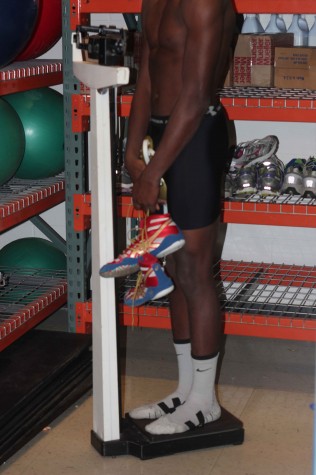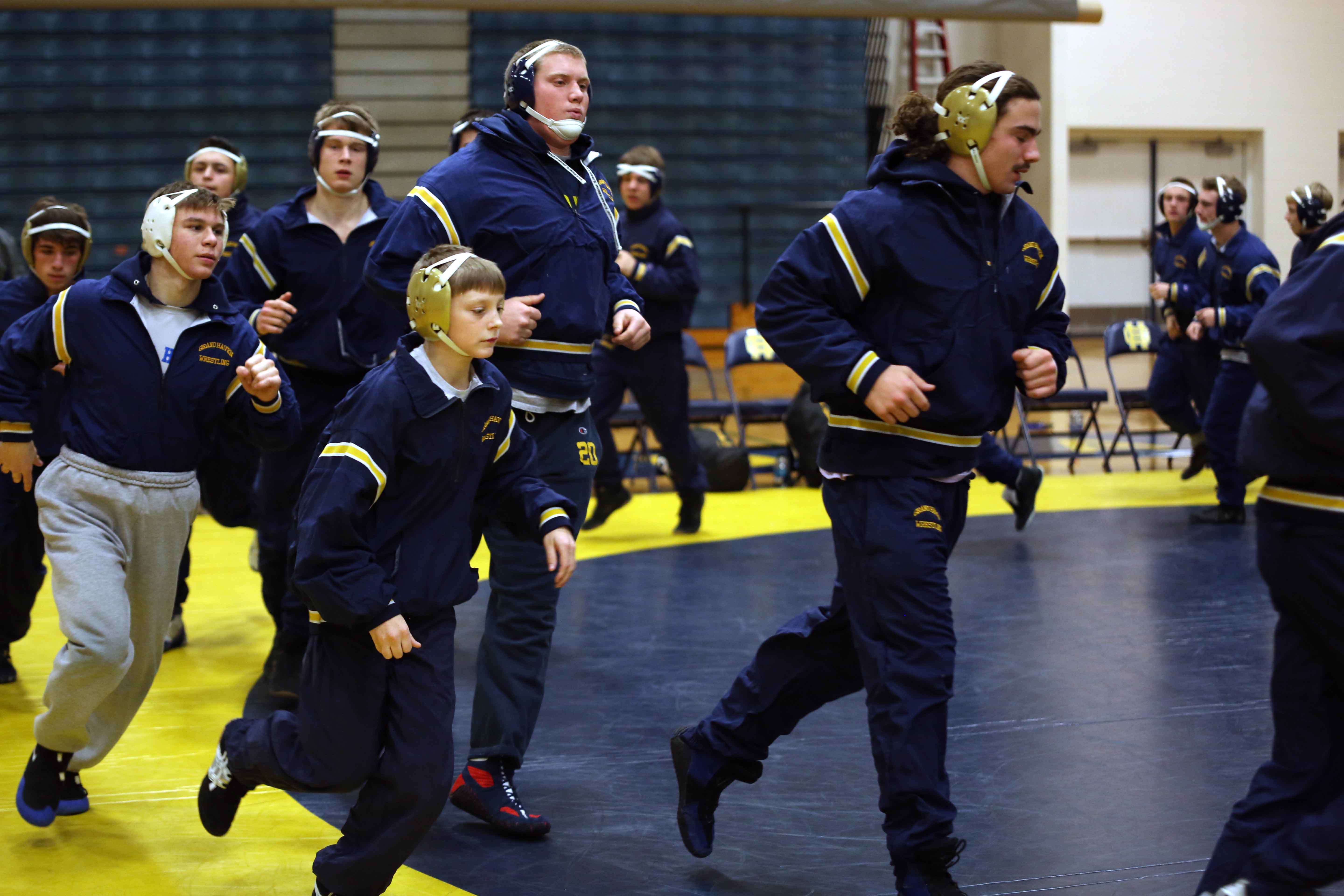Combat cutting weight
December 18, 2014
Two bare feet pad across a cold tile floor. A scale sits silently at the other end of the room underneath a single ceiling light. It gives off an ominous aura, the kind of intimidation that is caused by both the fear of failure and a fear of the unknown. The two feet step up onto the platform and the needle on the scale begins to swing from left to right.

Senior Aaron Cumming check his weight. On average a wrestler will lose 5-6 pounds during a single practice. The pounds shed is water weight and is gained back once hydrated.
A breath is inhaled.
The needle comes to a stop.
A breath is exhaled.
Two pounds over.
The two feet slide back into wrestling shoes and trudge towards the sauna to sweat off those last two pounds.
For many wrestlers, this scene was a weekly reality.
“When I cut weight a long time ago it almost drove me out of wrestling,” wrestling coach James Richardson said. “I didn’t like wrestling anymore because of weight cutting. So I feel very strongly that the emphasis should be on getting better and not cutting weight. I don’t believe in weight cutting.”
But after three collegiate wrestlers died in six weeks from extreme weight cutting, the NCAA implemented a new weight management program for the athletes. This program, developed in 1997, is what all high school wrestlers follow today when it comes to watching the scale.
Wrestlers manage their weight so they can compete in specific weight classes. This gives wrestlers a fair opportunity to compete against opponents of similar size and strength.
“A lot of times wrestlers try to find what weight is the most competitive,” assistant wrestling coach Vince Gervais said. “And some wrestlers cut weight to help the team fill a weight class, an unselfish decision.”
Previously a coaching belief was that if a heavier wrestler cut down to a smaller weight class, they would gain a competitive edge over their opponent by being bigger than them. But along with this belief came the tradition of dangerous methods and extreme exercise techniques that would help competitors lose those last few pounds. At Grand Haven, wrestlers are instead encouraged to make a decision about their weight and handle it responsibly.
“I know some kids in our conference whose coaches are very strict on weight,” senior wrestler Aaron Cummings said. “But our coaches make sure if we want to drop weight it’s our decision. Then we talk about it so we do it right.”
To ensure this ‘competitive edge’ wrestlers would spend days dehydrated, restrict their caloric intake and take the heat of the saunas to induce sweating so they could compete in the lowest weight class possible. Some would even go as far as exercising in plastic suits to increase the amount of water weight lost or using laxatives and other diuretics. According to athletic trainer Patrick Wykes, the use of these methods can have dire consequences.
“In the worst case death could happen.” Wykes said. “But there are a lot warning signs that are going to happen before that, where you’re going to have dizziness, nausea, fainting. Even kidney damage because you don’t have enough water so anything that goes into your body is not able to filter through your kidneys. On the less scary and severe side though, wrestlers are going to be fatigued and dehydrated. You can’t perform at the level you normally could.”
The NCAA and MHSAA have put in regulations to purge the wrestling community of these dangerous practices. According to the National Wrestling Coaches Association Director Mike Moyer, these methods are outdated and will not be tolerated in the wrestling community..
“We have come a long way in safeguarding wrestlers from the potentially tragic consequences of improper weight loss,” Moyer said. “Better technology has made this safeguarding system more efficient.”
Wrestlers are now required to take an Alpha Test. This ensures that a wrestler is hydrated and also determines the lowest weight that they can be while maintaining a seven percent body fat for males and 12 percent body fat for females . On top of the test, wrestlers cannot lose more than 1.5 percent of body fat per week, which allows for a healthy transitions to a lower weight class.
“This helps for the guys to lose the weight correctly..it evens out to about two pounds a week.” Wykes said. “In one practice a guy might lose five or six pounds because they are sweating and losing water weight. But after practice they are going to hydrate and gain that back.”
Along with the testing, education has become a huge part of the weight management process of wrestling. There is now a state mandated nutritional speech that all wrestlers are required to listen to.
“It really just comes down to education,” Wykes said. “Talking about what the guys are doing and eating, also holding them accountable too. That’s why they weigh in every single day, so that we constantly know where these guys are at.”
The education of the wrestlers on Grand Haven’s team does not come from the classroom. Instead, the videos, the talks and the responsible weight strategies for team success come from the coaches.
“Coach Richardson does a really good job of not pushing weight cutting,” Gervais said. “But the kids that do are educated on the proper ways.”
Although wrestling has come from a dangerous past, no longer will wrestlers in plastic suits be seen running in the gym or with empty trays in the lunch room. Instead, technique, performance and accountability are the main focus.
Our coaches make sure that if we want to drop weight it’s our decission
— senior Aaron Cummings
“The sport holds the athletes accountable,” Richardson said. “It’s very difficult to blame someone else for not throwing the ball, for not setting the pick, or the coach not playing you. Your efforts dictate your success.”
While the individualistic nature of wrestling may have once contributed to unhealthy habits, the focus has now shifted to acceptance.
“It is not your regular varsity sport, or for your typical athlete.” Cummings said. “It takes a certain type of mentality to do it. It’s not like a lot of other sports where you have to be a certain height or weight, anyone and everyone is welcome. But it’s not easy. If it was easy, everyone would do it.”
No matter the team, progress to eliminate dangerous weight cutting from young wrestlers has been made. But according to Moyer, there’s always more to be done.
“Clearly it’s a journey and it would be shortsighted to say that what is in place today is all that is necessary,” Moyer said. “We have come a long way, but we still have a way to go.”
